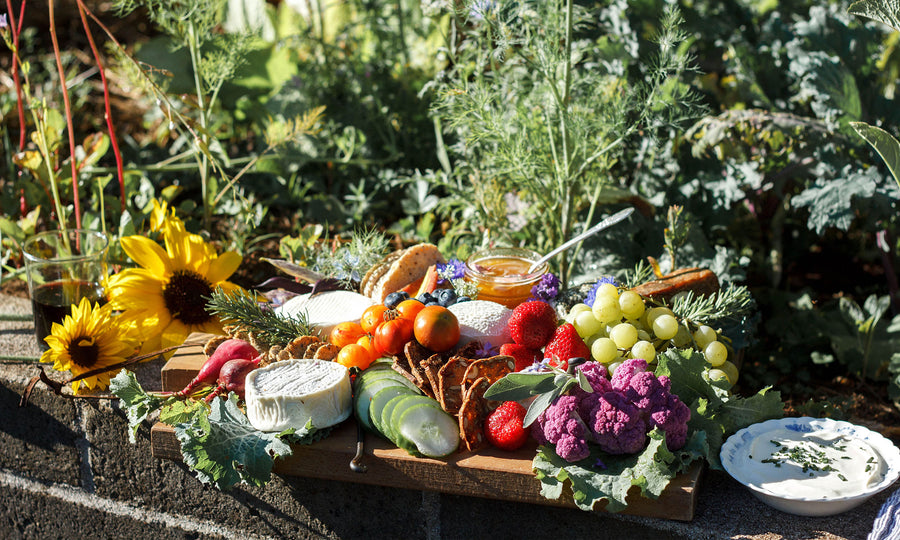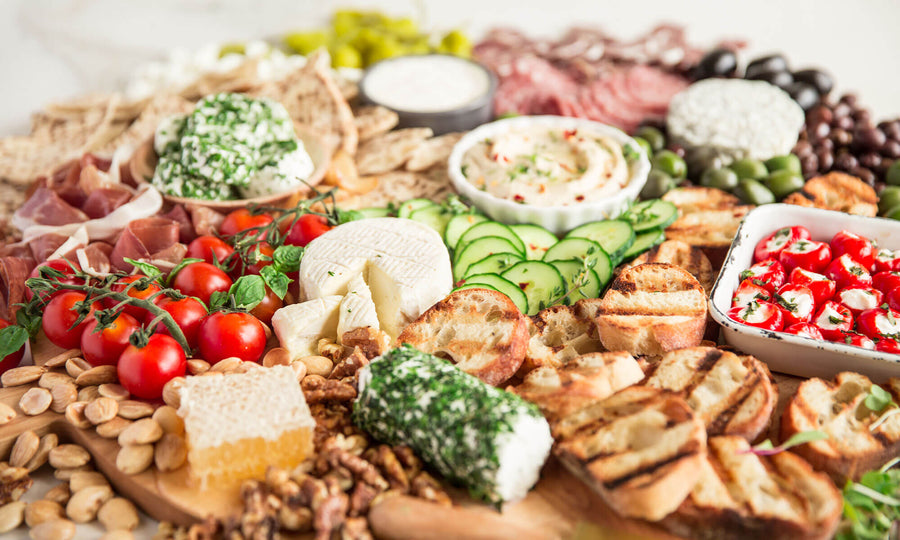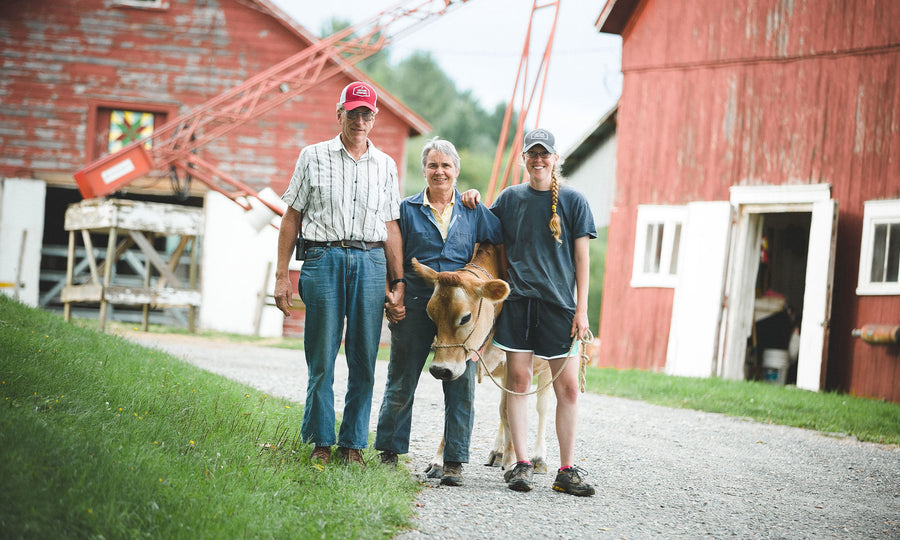Here in Vermont, it's not unusual to have snow in May — and sometimes even into June.
But even as farmers and gardeners shake their fists at the sky when snow blankets their newly sprouted crops, most also value the reminder that nature is fickle and the seasons change when they feel like it — and not before.
As everyday consumers, it's easy to forget that everything has a growing season. You can buy strawberries in February and sweet corn in November, but just because you have access to food that's been flown around the globe, that doesn't mean it's a great choice for your grocery cart.
That said, we get it: You can't get everything you eat from the farmer down the road (if you're lucky enough to have a farmer down the road)! But the more responsible eating choices we make in our everyday lives, the more we can help reduce global greenhouse gas emissions associated with growing food. And that's important, as the food system accounts for more than one-third of greenhouse gas emissions worldwide. That's a lot. And while you might not think it matters whether you eat that lettuce in your veggie drawer or it turns into green slime, the daily choices we make do make a difference.
Vermont Creamery's business model depends on agriculture, which depends on a healthy planet. Because of that, we've learned a few ways to be the best stewards of the environment that we can — both as a company, and as a group of everyday citizens who just happen to work together crafting delicious dairy products. So here are some of our favorite ideas to help all of us eat for a healthier planet.
Eat in Season
One of the best ways to reduce your impact on the environment — and to eat more delicious foods — is to take your eating cues from nature. If you don't know what's in season in your region, find out. Hit the farmer's market instead of the supermarket, and ask a farmer to give you a quick tour of what's fresh and in season. In addition to learning the growing cycle, you're also likely to try a few new-to-you foods that you might otherwise have passed by. Plus, farmers are often great sources for recipes and meal-prep ideas to make the most of your produce.
Eat Locally
When you choose food that's grown closer to home, it travels a shorter distance, shrinking its environmental impact. Local food is often better for you, too, as it's picked at the peak of ripeness, which means it's full-to-bursting with beneficial vitamins and nutrients. One way to challenge yourself to eat locally is to join a Community Supported Agriculture program, or CSA. By choosing a local farmer to provide fresh, seasonal food on a regular basis, you're giving back to your community, supporting local business, and eating the freshest, most in-season products available to you.
Tackle Food Waste
Here in the U.S., we waste between 30-40% of our food, which adds up to about a pound per person, per day. That means that a family of four throws out about $1,500 in wasted food per year. Not only is that bad for our wallets, but it's also bad for our overflowing landfills, where rotting food contributes about 8% of total greenhouse gas emissions. Plus, with more than 54 million Americans dealing with food insecurity, it's time to stop wasting food and start eating it. Here's some help cutting waste:
- Go to the grocery store or farmers' market with a list to avoid overbuying. (Bonus points if you come up with a specific meal plan for the week in advance!)
- Find some new recipes that utilize the entire fruit or vegetable. You can make pesto or salad dressings from all sorts of past-their-prime herbs. Or try saut?ing wilted spinach greens with garlic, red pepper flakes and olive oil to transform that aging box of greens into something delicious.
- Freeze leftovers to eat later. Just remember to label and date your containers to avoid mystery meals!
- Try buying frozen fruits and vegetables. They're usually flash-frozen at the peak of ripeness, so you can thaw or cook what you need without defrosting the whole bag.
- Institute "leftover day," to make use of any aging food you may have lurking in your fridge.
- Seek out "seconds," which are slightly blemished or otherwise irregular foods that are frequently sold at a discount. Imperfect Foods does this on a large scale, and we're happy to offer Vermont Creamery Cultured Butter sold through the platform.
Start a Compost Bin
If food in your kitchen is too far gone to salvage or transform into something else, the next best place for it is your compost pail — not the trash. Landfills are the third-largest industrial emitter of methane (a potent type of greenhouse gas), and rotting food takes up more space in landfills than any other trash. Imagine if all — or even most — food waste was composted. Instead of 80 billion pounds of waste, we could be producing a large quantity of rich, transformed soil that's like black gold for gardeners. You don't have to be a large-scale grower or have a big backyard to compost, either — small self-contained composting stations make it easy to turn food scraps into compost. You may also be able to bring your food scraps to a local facility where they can do it for you. Here in Vermont, it's now illegal to throw away food scraps, but it's very easy (and cheap) to compost them instead.
Grow Your Own
You don't have to own acres of land to grow some of your own food. Many types of tomatoes grow in pots or bags, while you can grow carrots in buckets, beans in window boxes, and herbs in a sunny windowsill. Self-contained hydroponic gardens with grow lights and seed "pods" mean you don't even need sun to grow your own food. If you do have space for a garden, look to easy-to-grow fruits and vegetables to start with, such as beans, lettuce, cucumbers, squash, or herbs. You might also consider starting a "no-dig" garden, which doesn't require rototilling and instead focuses on improving the soil without tearing it up. While a no-dig garden requires a bit of research and prep work, it's a far more environmentally friendly way to garden.
Share the Bounty
Finally, the best way to reduce waste, shrink your carbon footprint and increase the joy of eating well is to share with others. Here in Vermont, one in four people suffer from food insecurity. Find out if you can donate excess fresh foods to a food bank or other local organizations that can turn it into nutritious meals, or simply offer to split a CSA or your garden yields with a friend or neighbor who could use it. Being a citizen eater is all about being mindful of the earth, and to our fellow citizens on it. By sharing your bounty with others, you're directly impacting your community and keeping your produce drawer on the up-and-up.
What Vermont Creamery is Doing
Here at Vermont Creamery, we do our best to contribute to a healthier planet through responsible business practices and by setting specific goals to reduce our environmental impact and minimize waste. We power 100% of our Creamery through renewable energy produced on farms through "Cow Power." And finally, we're a certified B Corp, which means that we hold ourselves to the highest standards of social, environmental, public, and legal accountability. So we invite you to join us in doing everything we can to make this world a little greener — and a little better — for the generations to come.




